Next year, Manheim will observe its 260th birthday. However, even before it became known for its glasswork, farming traditions, auto auction, football prowess and now, a rebirth of creative energy, Manheim’s story relates to William Penn, the man whose vision of a sylvan utopia entailed democracy, religious freedom, “laws of behavior” and a city designed unlike any other. Manheim also celebrates its founder, Henry William Stiegel, whose life was an American success story until it all came crashing down.
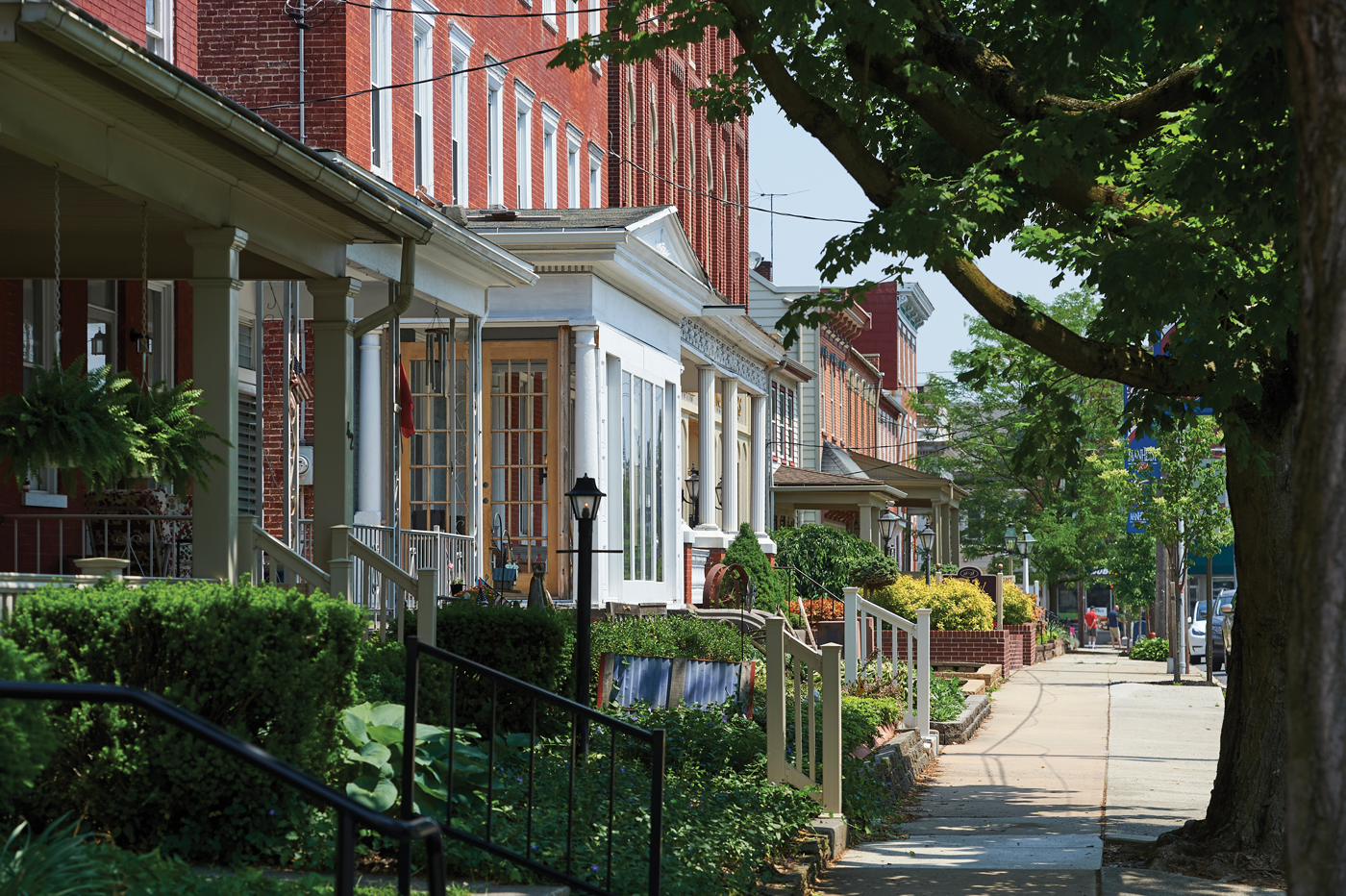
Market Square is lined with buildings that exemplify adaptive reuse, as most now shelter businesses. On the opposite side of the square, building styles are a mix of old and new as a result of Manheim’s largest fire, which occurred in December 1998. Four buildings were damaged/destroyed in the wake of the fire that saw more than 200 firefighters from 40 companies arrive on the scene to provide assistance to the Manheim Fire Company.
Born in England on October 14, 1644, William Penn faced adversity from a very young age. Contracting smallpox as a small child compromised his health. Thinking fresh air would help to restore their son’s health, the Penn family left London and took up residence in the country, where the younger Penn adopted a lifelong interest in agriculture. As a son of privilege, he attended the best schools. Penn also took an interest in the religious revolution that was occurring across Europe and, through doing so, became a member of the Society of Friends at the age of 22.
Penn’s religious conversion and the fact that he participated in protests against the policies of the Crown, led his father to disinherit Penn on several occasions. At one point, seeking to punish their son and separate him from the political and religious turmoil taking place in England, his parents banished Penn to Paris. Legend has it that Paris is where Penn developed his fashion sense and dressing in style became a lifelong obsession – despite the fact that he was a Quaker.
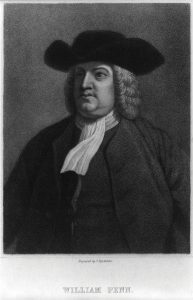
Land that was originally part of the Penn Grant in the Manheim/Rapho area was gifted to William Penn’s secretary, James Logan, and eventually was inherited by Logan’s granddaughter. In 1762, it came to be owned by Henry William Stiegel and his business associates.
Penn returned to England in time to witness two catastrophes. The first was the Great Plague pandemic of 1665. According to historic-uk.com, the flea-borne plague “started in the East, possibly China, and spread quickly through Europe.” Diarist Samuel Pepys reported that the streets of London became eerily quiet, as residents either quarantined behind closed doors or fled to the country, neither of which provided much protection.
During the summer of 1665, 15% of London’s residents succumbed to the horrendous disease. By fall, cooling temperatures helped to quell the flea population and with it, the pandemic. Outbreaks would continue to occur throughout time across the world, but not to the degree the disease was transmitted in 1665.
The following year, disaster of another kind struck. A summer of drought caused the wood-constructed buildings of London to become tinderboxes and on September 2, when a fire broke out at a bakery and spread to neighboring buildings, calamity ensued. In a matter of hours, 300 buildings were destroyed. The fire raged for four more days; even the king joined the fire brigade. Hoping to create a firebreak, gunpowder was employed to act as explosives. The resulting noise caused the rumor mill to go full tilt and word spread that the French were staging an invasion.
By September 6, the fires were fully extinguished. Only a fifth of London was left standing. All of its civic buildings were destroyed, as were 13,000 privately owned buildings and homes. Sir Christopher Wren was charged with rebuilding the city. He was especially proud of what he deemed his masterpiece – St. Paul’s Cathedral, which was built between 1675 and 1711.
Despite his displeasure with Penn’s activities, the elder Penn’s last act on this Earth was to ensure his son’s safety by securing the protection of the Crown for him. Penn, meanwhile, discovered that the king was indebted to his father for a large sum of money. To settle the debt, Charles II offered Penn 45,000 square miles of land in the New World. The transaction would make Penn the owner of the largest, privately held tract of land in the world. The Penn Grant was finalized in March 1681.
Penn viewed the acquisition as a “Holy Experiment” – one that would provide its citizens with religious freedom. In order to fund his experiment, Penn began selling land to settlers and investors. He also devised “laws of behavior” for what would become Pennsylvania: drinking, swearing, gambling, cockfighting and theatrical productions were forbidden. He also designed the city of Philadelphia to be unlike European cities in that numbered streets would intersect with those named for trees and green spaces would abound.
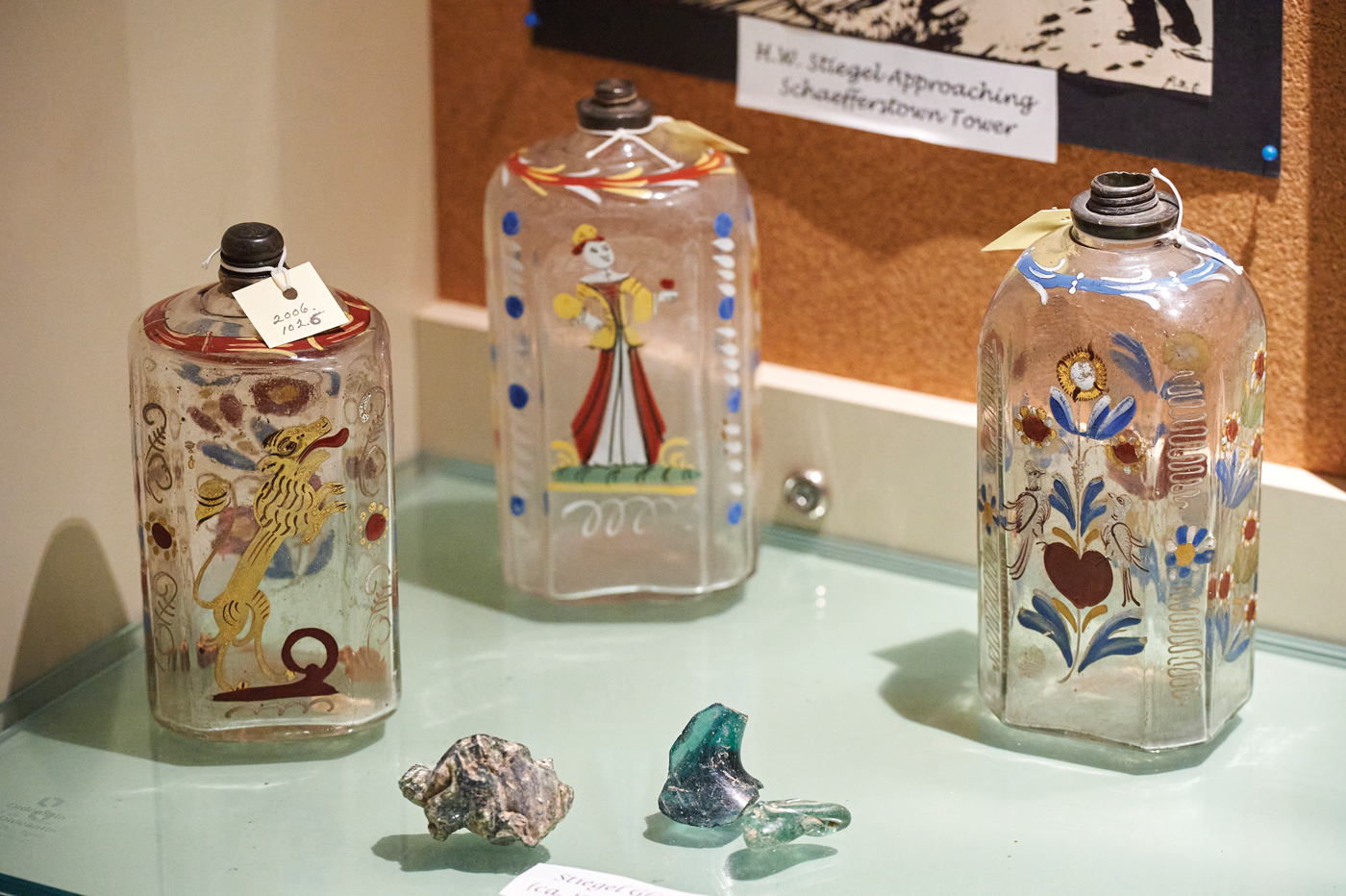
The Manheim Historical Society’s museum, which is located in the former railroad station, is home to a collection of Stiegel glass that predates the American Revolution. The display will grow this summer thanks to an acquisition of a private collection that will also include stove fronts and other Stiegel artifacts.
Penn lived in the province from 1682 to 1684, at which time he returned to England with the hopes of settling a border dispute with Charles Calvert, who had inherited the title of Lord Baltimore from his father, Cecil. Like Penn, the original Lord Baltimore, George Calvert, was a convert (Catholicism) who dreamed of creating a refuge for Roman Catholics in the New World. The land he was granted would become the state of Maryland.
George Calvert died before he could see his dream to fruition and so it fell to his son, Cecil Calvert, the Second Lord Baltimore to carry it out. Upon his death in 1675, Cecil’s son, Charles, inherited the title, the land holdings and what would become a feud with William Penn.
Penn argued that his land extended south to the Chesapeake Bay, while Calvert placed the border between the 39th and 40th parallels. While Penn laid claim to the northern reaches of the Chesapeake Bay, Calvert deemed Philadelphia to be among his holdings.
The wrangling continued into succeeding generations (Calvert died in 1715 and Penn in 1718). Finally, two of England’s best surveyors – Charles Mason and Jeremiah Dixon – were assigned the task of determining the border between the two areas. Work commenced in 1763 and culminated in 1768, with members of the Penn and Calvert families agreeing with the final – and definitive – results.
Penn’s stay in England lasted 15 years. He and his second wife, Hannah Callowhill Penn, finally left for Pennsylvania in 1697. Two years later, Penn was back in England, only to be sentenced to debtor’s prison as a result of his agent defrauding him and causing him to lose nearly all his land in the New World. On top of that, his namesake son and heir apparent was unqualified to take over the province, as he had become addicted to gambling and renounced his Quaker faith and upbringing.
As Penn’s health began to fail beginning in 1712 – he suffered a series of strokes – Hannah took on the leadership role of governing the province. The mother of eight (Penn, a widower, married her when he was 52 and she was 25) continued in that role until her death in 1726. Unknowingly, her parents had prepared her for the role. She was the only child (of nine) to survive into adulthood. Needing help with their business dealings, they had no choice but to teach Hannah accounting and managerial skills. Many organizations recognize her as Pennsylvania’s second governor. In 1984, she became the first woman to be given the title of Honorary Citizen of the United States, which requires an act of Congress.
Philadelphia, of course, reveres William Penn. That was especially evident when a 37-foot-tall statue of him was placed atop City Hall, which was completed in 1901. A gentlemen’s agreement among developers laid out a plan that declared new projects would respect Penn’s “stature” and not exceed a height taller than the top of his hat. The precedent endured until 1987, when One Liberty Place was completed. The project led to other high-rise projects that defied the agreement. William Penn became lost in a sea of towering skyscrapers.
The disrespect shown to Penn prompted a “curse” to be born. For the next 20 years, Philadelphia’s sports teams were denied championship seasons.
The drought was brought to a merciful end thanks to a topping-off ceremony that was held at the new and towering Comcast Center in 2007. When the final beam was put into place, it was topped by a statuette of William Penn. A year later, the Philadelphia Phillies won the World Series. Ten years later, Comcast conducted a topping-off ceremony at the even-taller Technology Center (tallest building in Pennsylvania) that continued the tradition of placing a statuette of William Penn atop the final beam. A year later, the Philadelphia Eagles won the Super Bowl.
Finally … the Manheim Connection
The Manheim area was originally part of William Penn’s land grant. In 1734, a tract was given over to Penn’s devoted secretary, James Logan, by Penn’s surviving family members. The tract passed from Logan to his granddaughter. In 1762, it attracted the attention of three Philadelphia businessmen: Henry William Stiegel and brothers Charles and Alexander Stedman. Stiegel took the most interest in the area, which prompted local farmers to refer to it as Stiegeltown. He preferred to call it Manheim in honor of the German city, Mannheim.
Stiegel’s is an American success story. That is, until it all came crumbling down. Stiegel, his mother and brother emigrated from Cologne, Germany, and arrived in Pennsylvania in 1750. He found employment with the Stedman brothers, Scottish émigrés who escaped prosecution relating to a ploy to overturn the House of Hanover and restore the Stuarts to the English throne. The Stedmans settled in Philadelphia, where they engaged in importing goods to the colonies. Their ships were also used to transport untold numbers of immigrants to the colonies.
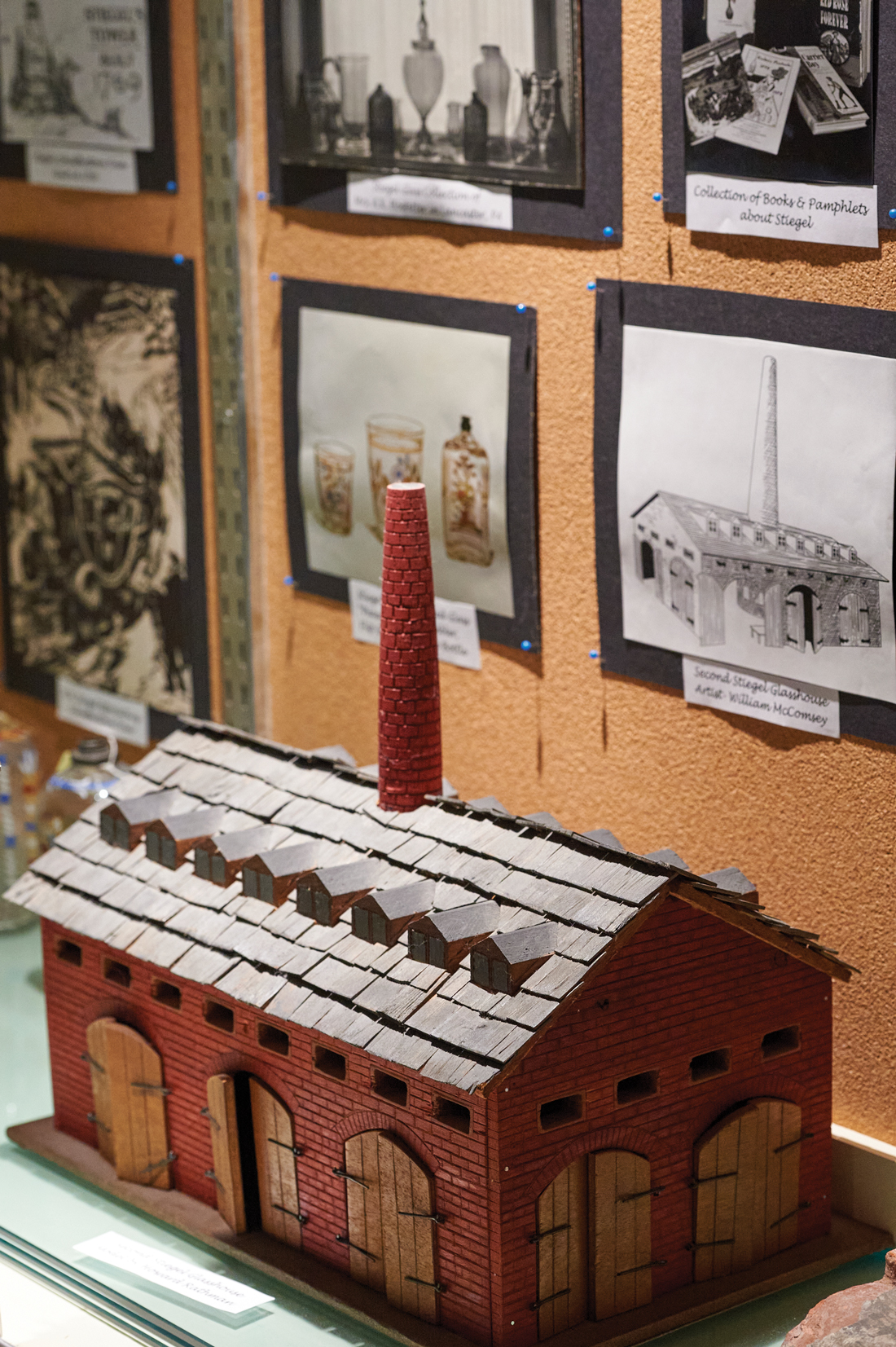
A replica of the Stiegel Glassworks Manufactory, which was located about two blocks from the Manheim Historical Society’s headquarters, is on view in the organization’s museum.
During his two-year tenure with the Stedmans, Stiegel became associated with Jacob Huber, who owned what became known as Elizabeth Furnace, which was located in what is now Brickerville. Starting as a clerk, the ambitious Stiegel progressed to the point where he became a part-owner of the enterprise. He also married Huber’s daughter, Elizabeth, who tragically died soon after giving birth to their second daughter. (He later married Elizabeth Holtz of Philadelphia.) Following Jacob Huber’s death, Stiegel became the owner (along with some investors) of Elizabeth Furnace (he named it in honor of his wife). Stiegel increased his holdings with the purchase of Charming Forge in Womelsdorf, Berks County.
Success in business prompted Stiegel to become active in civic and church affairs. He was one of the founders of the German Society of Pennsylvania, whose intent was to provide aid to newly arrived Germans. He harbored a desire to create a community that would be populated by German immigrants and went to work designing a town in the center of Rapho Township, which had been carved from Donegal Township in 1741. Stiegel designed a town center that included an open area – now Market Square – a mansion for him and his family, offices for his enterprises and a manufacturing plant for his latest endeavor – glass.
The “glasshouse” began operating in 1764 and was soon attracting talented craftsmen from the colonies as well as Europe. Eventually known as American Flint Glass Manufacturing, the glass was so highly regarded that it drew comparisons to the finest glass made in Europe.
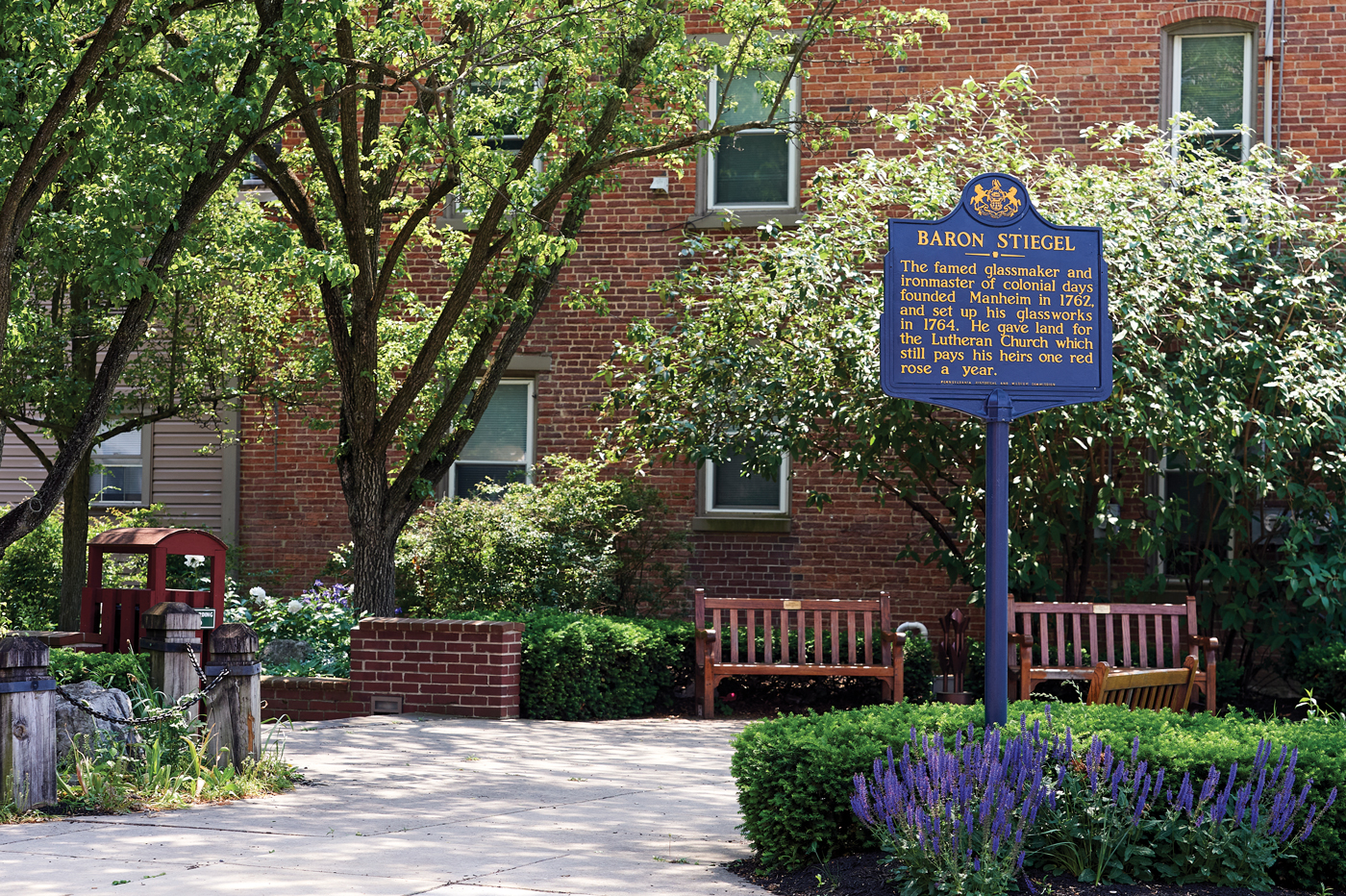
A Pennsylvania Historical Marker that notes Stiegel’s importance to the town, is located in a small park that is located at the intersection of Main and Hazel streets.
It seemed everything Stiegel tried met with success. His lavish lifestyle reflected that, prompting residents to begin referring to him as Baron Von Stiegel. However, his ever-growing fortune wasn’t spent entirely on life’s luxuries. Stiegel valued education and he bankrolled the construction of schools and hired and paid the teachers. Students were primarily the children of his workers.
Stiegel also loved music. He supported a community band and directed the choir at Trinity Lutheran Church in Lancaster on the occasion of its dedication service in 1766. A devout Lutheran, Stiegel was instrumental in providing the congregation of Zion Evangelical Lutheran in Manheim with a church building by deeding land to its members in 1772. The mortgage note was rather simple; Stiegel expected to be reimbursed with “five shillings and in the month of June hereafter the rent of one red rose if the same shall be lawfully demanded.”
Financial transactions among Stiegel, the Stedman brothers and other Philadelphia investors provide evidence that Stiegel gradually became the sole “owner” of the town. When relations between England and the colonies began to sour in the years preceding the American Revolution, Stiegel and other wealthy business owners saw their empires collapse. For a time Stiegel (as well as Charles Stedman) was incarcerated in a debtor’s prison.
Upon Stiegel’s release from prison, Robert Coleman, who had purchased Elizabeth Furnace, hired him to return to the furnace and oversee the German-speaking workers – including POW Hessian soldiers, who were sent there to provide needed manpower in exchange for monies owed to Coleman by the Continental Army.
During the war, attempts were made to restart operations at the glass factory, as medics were in dire need of medicine bottles. Without Stiegel’s leadership and expertise, the venture failed and it was permanently shut down in 1780. The loss of such an industry greatly impacted the town of 300. Ten years later, the census showed a gain of only 65 residents.
As for Stiegel, he survived by taking on jobs such as bookkeeping and teaching. He died on January 10, 1785.
Interestingly, events surrounding the signing of the Declaration of Independence on July 4, 1776, brought some well-known names to Manheim. It is believed that as many as 14 signers of the declaration took up temporary residence in Manheim, including Robert Morris. For a time, Benjamin Franklin’s daughter lived in Manheim. What was the allure of Manheim? It provided them with a safe place – after all, the Crown had placed bounties on their heads – yet was only a day’s ride from Philadelphia.
In 1790, the town was officially given the name Manheim. In 1838, the state legislature recognized it as a borough.
Sources: Manheim Historical Society, Philadelphia Magazine and historic-uk.com
Paying the Rent: Festival of the Red Rose
Since 1892, Manheim’s Red Rose Church – Zion Evangelical Lutheran – has been hosting the Festival of the Red Rose to honor the 1772 “sale agreement” through which Henry William Stiegel and his wife, Elizabeth (Holtz), provided the Lutheran congregation with land on which to build their church. In addition to the sale price of five shillings, the Stiegels requested that “in the month of June hereafter the rent of one red rose…” be paid. Legend has it that a ceremony was conducted on two occasions – 1773 and 1774 – that saw Stiegel receive his payment of a red rose. Later in 1774, however, Stiegel was committed to debtor’s prison in Philadelphia and following his release on December 24, he never returned to Manheim. The rose ceremony simply became a historical footnote.
That is, until 1892, when Dr. J.H. Sieling proposed that the church revive the tradition in the form of a festival that would pay tribute to the church’s beginnings. (The first two church buildings were log structures that sat in what is now the graveyard; the current church building dates to 1855.)
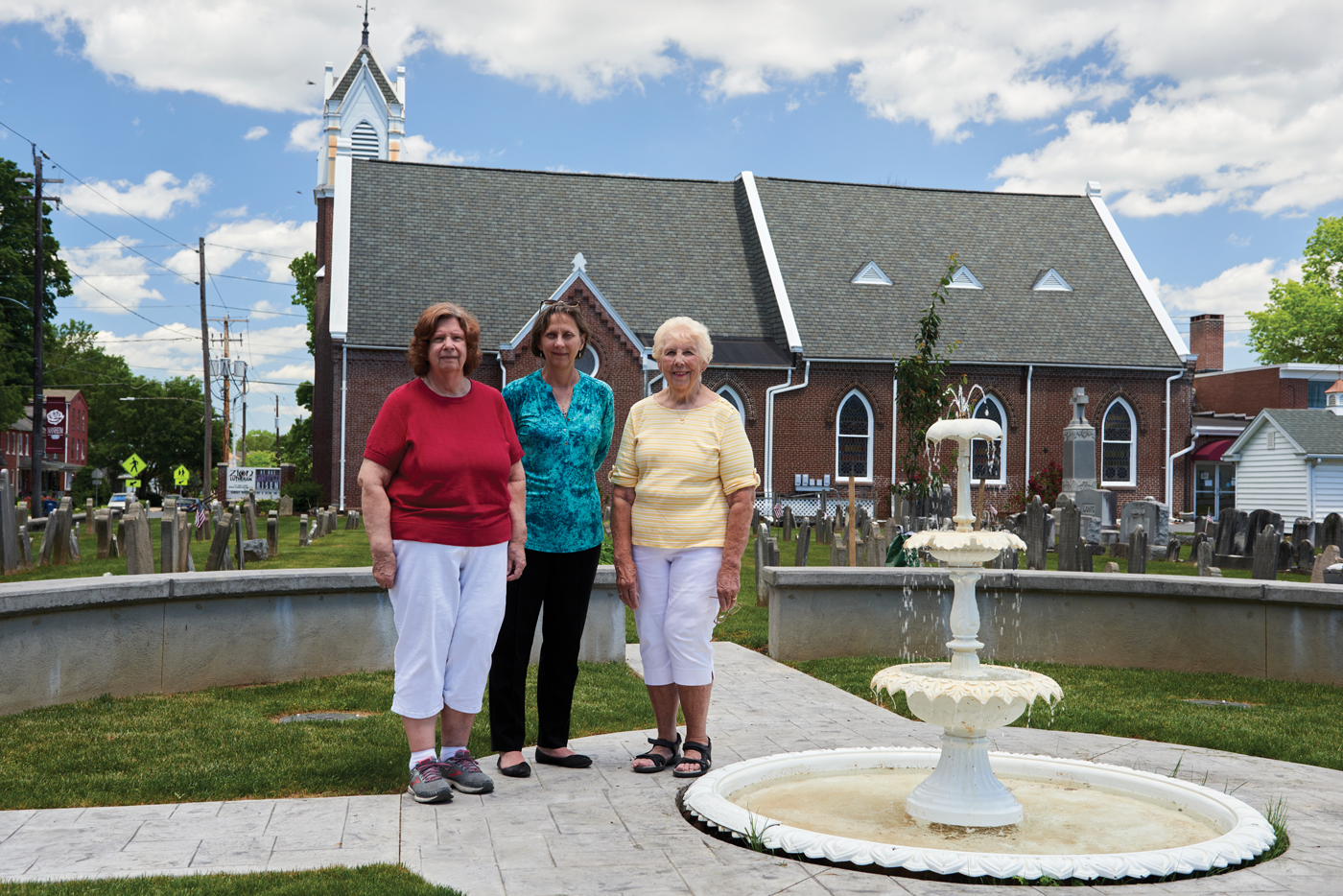
Zion Evangelical Lutheran’s historic fountain is now the centerpiece of the church’s Memorial Garden. The congregation’s first two buildings were constructed from logs and stood in the vicinity of where the Memorial Garden is now located. The present-day church dates to 1855. Left to right are: Linda Keiffer, who is a life-long member of the church and has served as the chair of the Festival of the Red Rose for the past five years; Rev. Kate Warn, who has been the church’s pastor for the last three years; and Martha Rudisill, a festival committee member, who still calls herself a “transplant” despite moving from York to Manheim 51 years ago.
The Festival of the Red Rose, which is always held in June, when roses reach their peak bloom time, was born. Drive through Manheim in June, and red roses seem to be blooming everywhere! The centerpiece of the festival is the presentation of a red rose to one of Stiegel’s descendants. In 1892, John C. Stiegel of Harrisonburg, Virginia, did the honor of accepting the rose. In 2016, his great-great-grandson, Joseph Douglas Ragan III – a ninth generation descendant of Stiegel’s – did the honors. Ragan’s mother, Barbara Wood, was a past recipient, as well.
Linda Keiffer, who has been a church member since she was a baby (she is 71 years old) has headed the festival’s planning committee for the past five years. While this year’s festival, which was held June 13, wasn’t as elaborate as those in years past because of the pandemic, she was excited to see it return to some semblance of normality. “Last year, we did a drive-in event and eliminated the rose ceremony,” she explains.
“When we started planning for 2021’s festival in January, we didn’t know what to expect, so we decided to go the safe route and move everything outdoors,” she elaborates, noting that the inside of the church is usually decorated with roses and ferns for the occasion. For this year’s festival, the committee worked with Enck’s Catering to find an alternative for the catered lunch that is usually served. “We did box lunches instead,” she adds. The timeframe was also moved to late morning in order to avoid the afternoon heat.
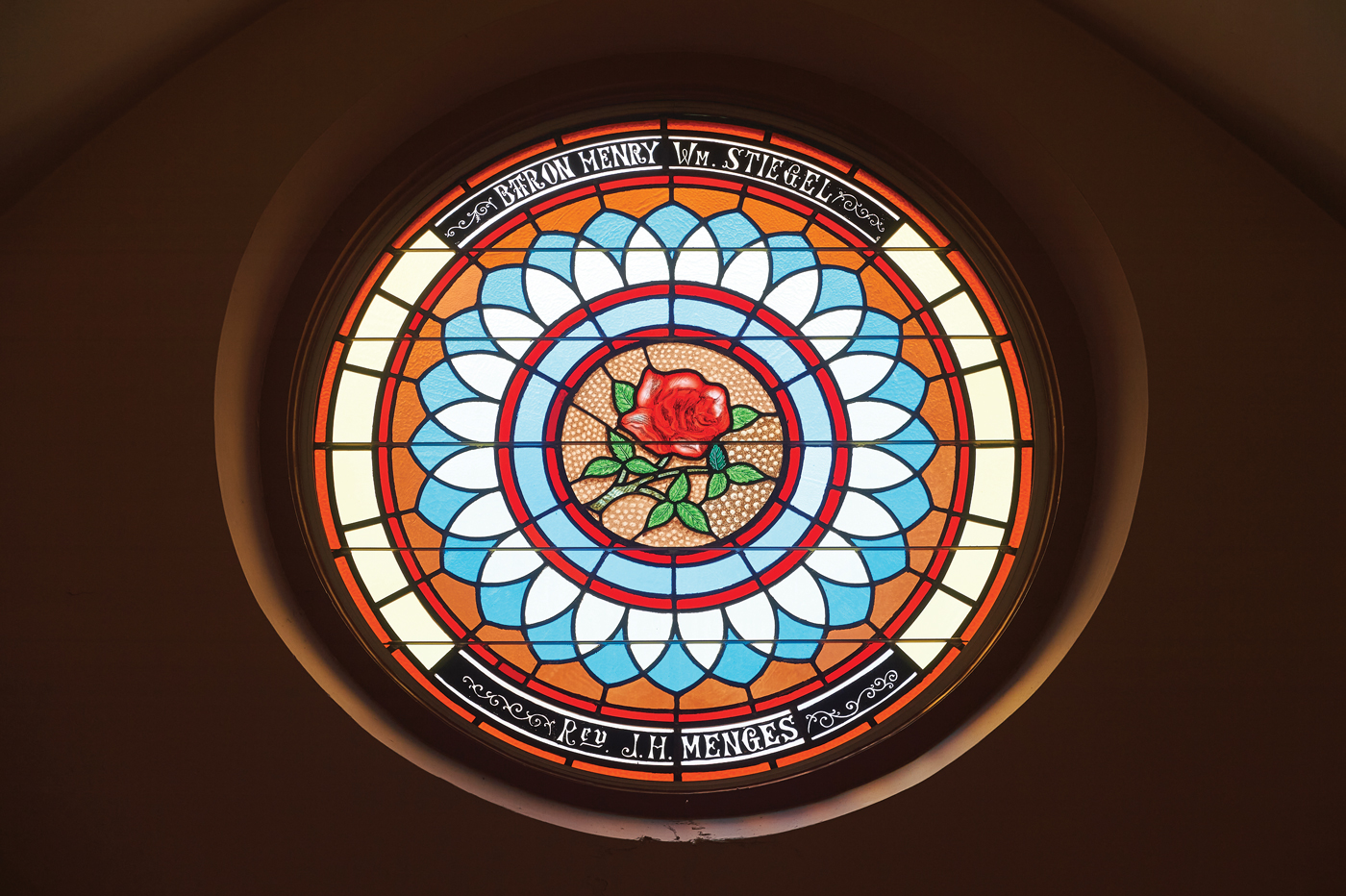
Being deemed the Red Rose Church, it’s only fitting that one of the stained-glass windows at Zion Evangelical Lutheran Church conveys its connection to Stiegel.
Other than that, the festival followed tradition and included a music program with the church choir, guest speakers, an ice cream social and, of course, the rose ceremony. This year’s Stiegel descendants included Stephanie Stover Carroll of Media, Delaware County, who accepted the rose for 2020, and her sister, Stacy Stover Prince of Westminster, Maryland, who accepted this year’s rose. “They are both ninth-generation descendants of Stiegel and his second wife, Elizabeth Holtz,” says Linda. “We make it official,” she shares. “An attorney is present – this year it was J.D. Young Jr. of Young & Young in Manheim – and a rent book is signed.”
Locating Stiegel descendants is made easier because of the late Millicent Cooper’s extensive genealogy research. According to Linda, many of the Stiegel/Holtz descendants make their homes in Virginia, which is where the Stiegels’ son, Jacob, migrated. “We invite all Stiegel descendants to the festival,” Linda explains. “The invitation letter always includes a genealogy chart that we ask them to update, as well as a form on which they can make recommendations for future recipients.”
Linda appreciates her role in the festival. “I love history,” she says. She’s also become quite the student on the life of Stiegel. “It’s such a sad tale,” she says of Stiegel’s rise and fall. “Where he is buried remains a mystery,” she shares. “He was visiting his nephews – their last name was Ege – in Berks County when he died. It was winter, so it’s speculated he was buried somewhere on their property.” (His first wife, Elizabeth Huber, is buried in the graveyard of the Brickerville United Lutheran Church and, according to a LancasterHistory.org article, Elizabeth Holtz traveled to Philadelphia to visit relatives sometime after Stiegel’s release from prison and unexpectedly died and was buried there.) “It’s also interesting that as flamboyant as Stiegel was, pictures of him don’t exist,” Linda shares. “You would think he would have had a portrait painted of himself.”
Now, the planning committee is gearing up for a stellar event in 2022 – it will be the church’s 250th anniversary. Pastor Kate Warn, who has been at the church for three years, is excited to be part of the milestone celebration. “I came from [an assignment] in East Africa and was looking to land in a strong community. I got my wish,” she says of Manheim. The grounds are already being spruced up with the addition of a Memorial Garden and new plantings of rose bushes. “My favorite is the Mr. Lincoln Tea Rose,” Linda says of the bright-red blooms it produces. She also hopes that descendants from both of Stiegel’s marriages will be present. “We already have two nominees,” she shares.
2 S. Hazel Street • Zionmanheim.com





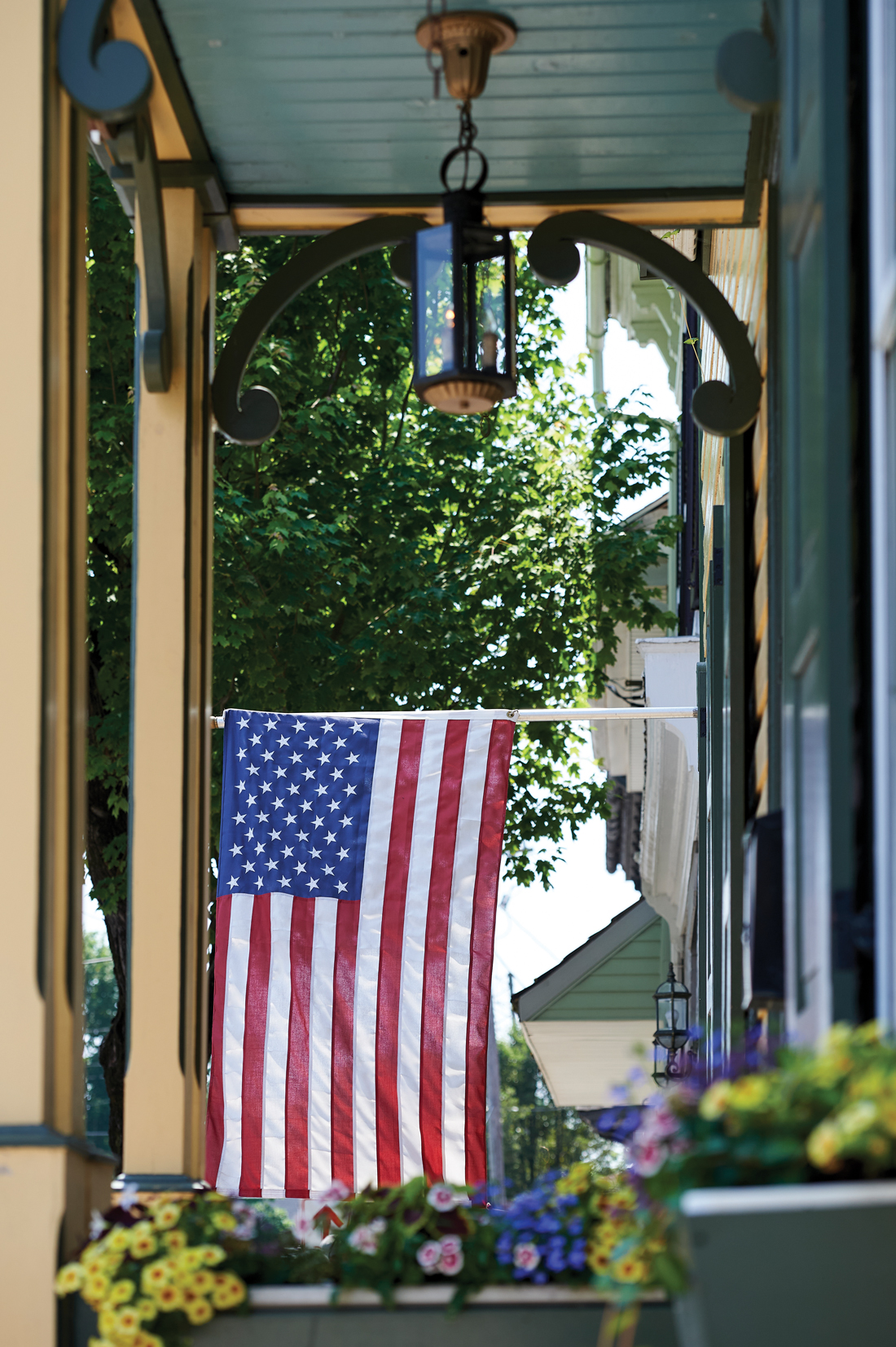
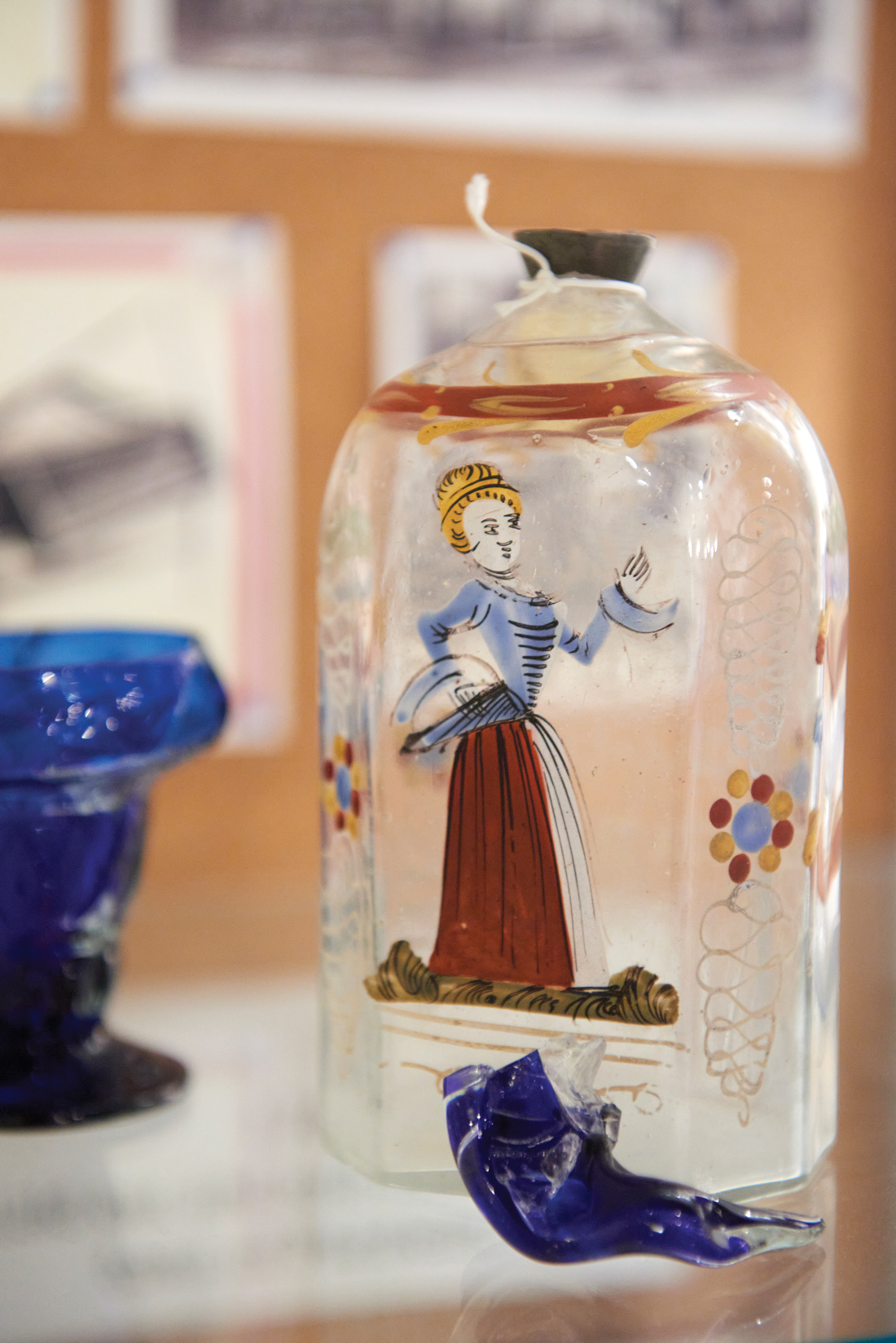
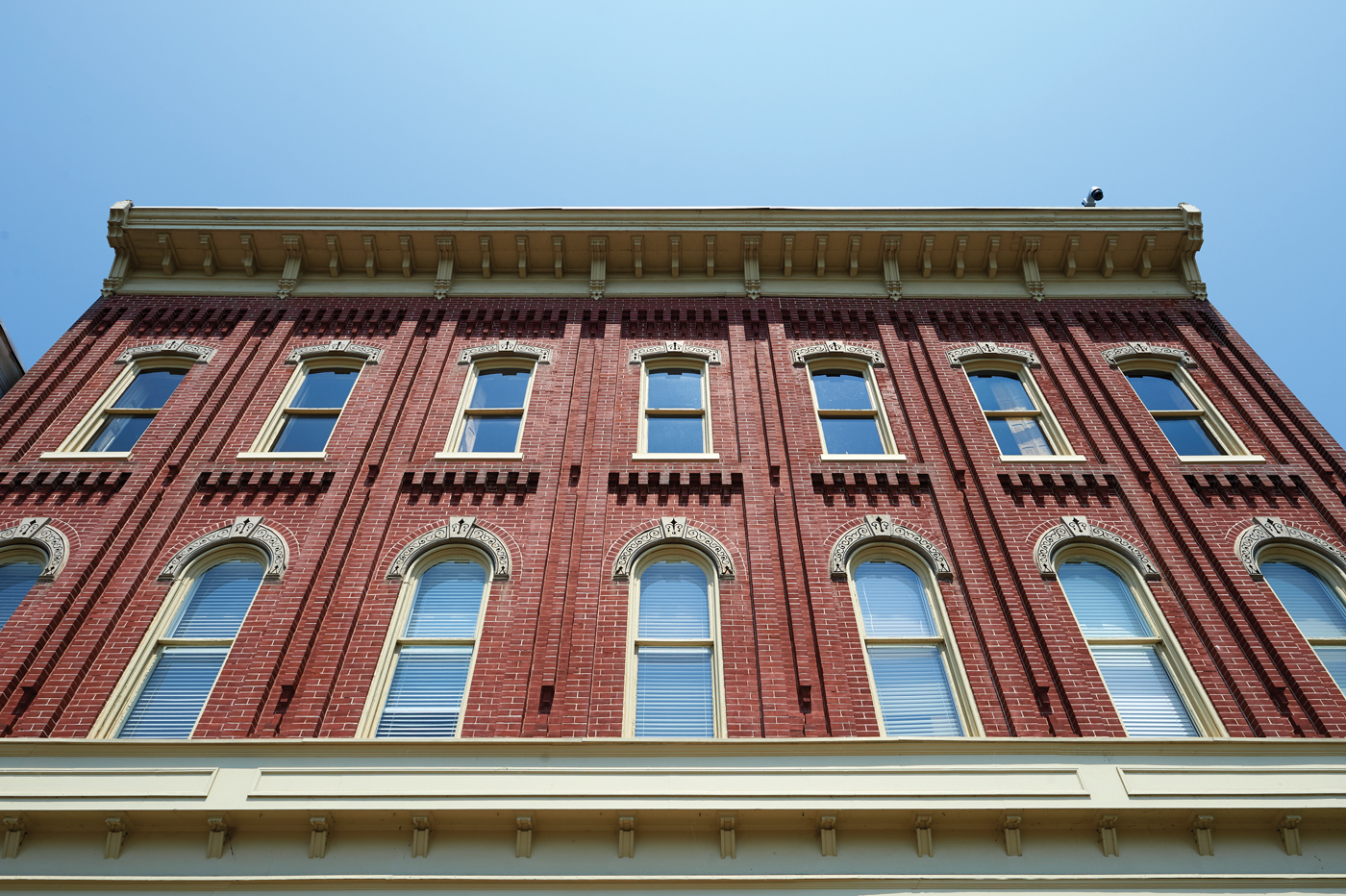
What a great history we have in Manheim!! It’s wonderful to see it come alive again! !!
I am the manager of Nearly Nu Thrift Shop and this year we are in business 40 years!! We see new people all the time. Some from Harrisburg, Hershey and Lebanon.